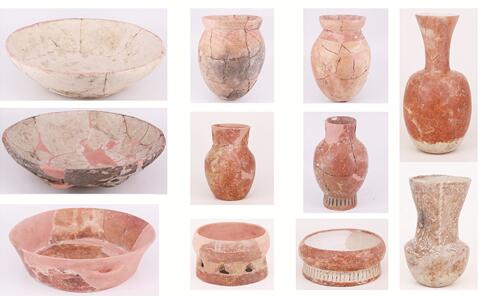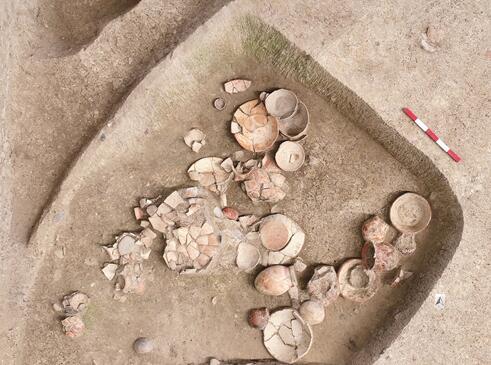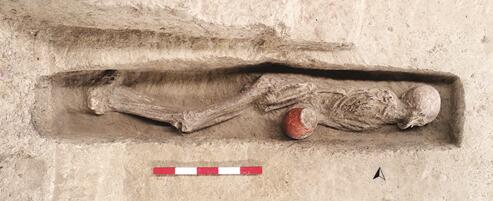9000 BP settlement with moat and terrace from Shangshan Culture found in Qiaotou site in Yiwu, Zhejiang
Qiaotou site is located in the west of Qiaotou Village, Chengxi Street, Yiwu City, Zhejiang Province. Since 2014, formal excavations of Qiaotou site have been conducted by Zhejiang Provincial Institute of Archaeology and Cultural Relics. Roughly an area of 2300 m2 of the site has been uncleared so far. Features from different periods have been unearthed, including a housing remain, 45 tombs, more than 160 pits and 3 ditches. Plenty of well-preserved pottery have been discovered from some pits of Shangshan cultural period, which might be regarded as “pits with typical artifacts ”. More than 110 recoverable potteries were found. Two tombs from late period of Shangshan culture are the earliest tombs, having relatively well-preserved human skeletons discovered in Zhejiang Province.

Unearthed pottery
According to the results of many years’ systematic excavations, Qiaotou site is shown to be a relatively independent settlement unit with moat and terrace. In the east, south and north sides of the site, there are man-dug moats. The west side of the site is destroyed by river. The middle part is a slightly square, incomplete terrace. East terrace and inner edge of the moat have been almostly preserved. Moat remains in Qiaotou site are quite complete, about 10-15m wide and 1.5-2m deep. With the inner edge of the moat as boundary, the site of central terrace is about 40m long.
Features from Shangshan culture conclude housing remains, pits, burials and so on. There are several post holes being placed in a certain pattern, indicating there might be architectural remains. The terrace possibly have functional divisions. Among them, housing remain (F1) is situated in south part of the terrace. In the pits, there are plenty of burned earth, being surrounded by post holes. In the north of terrace, the mainstream of the features are “pits with typical artifacts” and burials from Shangshan Culture, for example, there are lots of well-preserved potteries from deposits of H98, H150. Among them, more than 50 potteries being recovered were unearthed from H98. The potteries from the pits have certain stratigraphical relationships, which might be the results of several activities. M44 and M45, both from late period of Shangshan culture, are vertical earthen shaft pit tombs, where the deceased had fixed limbs lying on their sides and heading east. The skeleton from M44 is relatively well-preserved, facing south, with a pottery jar being placed between upper limb bones and pelvis. Both north and south parts of M45 have been broken by features from late period, the human skeleton is poorly preserved, facing north, without any complete burial goods.

Potteries in the ash pit
All in all, the moat was probably constructed and used during Shangshan cultural period, when there were relatively few garbages in the deposit, or, there might be intentional clearing. The terrace may be mainly used for feasting or ritual activities. However, these activities The function of moat and terrace had been weakened during the period of Kuahuqiao Culture. The moat was abandoned and there were plenty of garbages being found from Kuahuqiao Culture.
Pottery and stone artifacts are the main artifacts unearthed from Qiaotou site. Stone artifacts have motors, grinders, stone axes, stone adzes, stone knives and so on. Chipped stone artifacts are very rare. Potteries are relatively well-preserved, most of which are coarse clay pottery. The pottery usually have red coat, only a few have black-brown coat. Pottery shapes include basin with large mouth, plate with flat base, jars with egg-belly, pots with two handles, plate with round foot and so on. Pottery coats are very bright, most of which are red, and there are also cream coat, all reflecting high decoration skills. A certain number of painted pottery are discovered, including cream ones and red ones. Painted pottery from Qiaotou site have basic elements of painted pottery from Kuahuqiao Culture. Sun patterns from both cultures could be traced to the same origins, showing that Shangshan culture is an important original source of Kuahuqiao Culture.

The well-preserved skeleton
Based on the results of C14 dating, the site dates back to about 9000 BP. There is a relatively large area of high-land area in the east part of site, however, further archaeological excavation work is needed to explore whether there is an area related to the function of terrace.
Qiaotou site is an important early Neolithic settlement site with clear characteristics. Its excavations only enhance the understanding of Shangshan culture, but also bring the understanding of ca. 9000 BP cultures in upper reach of Qiantangjiang River, even southeast China to a new height. With the development of further archaeological excavations of Qiaotou site, a more clear and complete picture of livelihood, social structure and spiritual life of local people about 9000 BP will be revealed. (Translator:Ma Huanhuan)

